Gunpowder was invented in China in the 9th century. The Chinese fire lance, a bamboo tube that used gunpowder to fire a spear, was invented in the 10th century and is regarded by historians as the first gun ever made. The earliest known depiction of a gunpowder weapon is the illustration of a fire-lance on a mid-10th century silk banner from Dunhuang in Western China. The earliest depiction of a gun is found in a Dazu Rock Carving (Sichuan, China) dating to the 12th century. It shows a figure carrying a vase-shaped bombard with flames and a cannonball coming out of it. Firearms appeared in the Middle East between the late 13th century and early 14th century. Medieval Mughal historian Iqtidar Alam Khan argues that it was invading Mongols who introduced gunpowder to the Islamic world. The Dardanelles Gun, built in the Ottoman Empire in 1464 by Munir Ali, had a weight of 18.6 t and a length of 518 cm. It was capable of firing stone balls of up to 63 cm diameter. In Europe, one of the first uses of gunpowder as a weapon was at the Battle of Crécy (1346), when the English King, Edward III, fielded five cannons. Gun Shooting Competitions also have a long history. The first shooting clubs were formed by German-speaking peoples in the 13th and 14th centuries. The earliest recorded shooting match is one held in Eichstäat, Bavaria, in 1477. The shooters, probably using matchlocks, competed at 200 meters (218.72 yards).
Just as a quick aside, Koreans sometimes refer to the United States as the “Country of Guns”.
International Shooting Sport Federation (ISSF)
The International Shooting Sport Federation (ISSF) governs the World Shooting Championships. These championship matches began after the successful conclusion of the 1896 Summer Olympics. The first competition was held in 1897 in Lyons, France, The ISSF was not founded until 1907, but these early competitions are still seen by the organization as the beginning of a nearly continuous row of championships. The scheduling of the championship have changed over time, originally annually (1897 to 1931), then biennially (1933 to 1949), to the current quadrennial schedule (since 1954). (For the shotgun competitions only, there is an additional World Championship in odd-numbered years.) The competitions were not held during World War I, World War II and, for some reason, in 1926. Currently, these events are held two years before the Olympics and serve as qualification events for the Olympics. Like all competitions, the type and number of events have changed over time. Currently, they are composed of five disciplines: Rifle, Pistol, Shotgun, Running Target and Target Sprint. There are individual and team events, as well as Junior and Senior events.
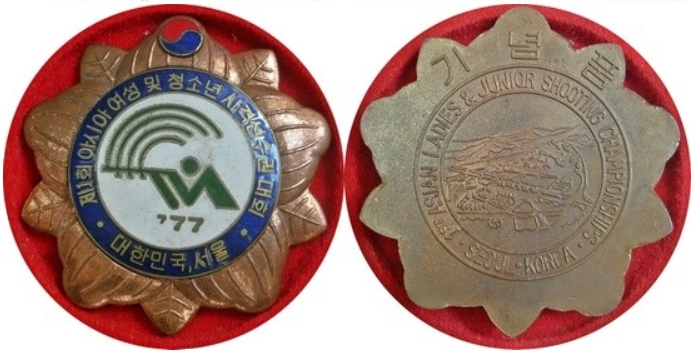
1st Asian Ladies & Junior Shooting Championships
Before the 1978 World Shooting Championship, there was a smaller, event that is virtually undocumented on the internet. The only thing that I have of substance is a picture of a medal for the event, and one pre-event newspaper article. The event was the “1st Asian Ladies & Junior Shooting Championships” 제1회 아시아 여성 및 청소년 사격선수 런대회. It was held on Sept. 20-23, 1977 at the Taeneung Shooting Range, which is the same range that the 1978 World Shooting Championship was held. There were 104 competitors from 7 countries, including Korea. The women competed in small caliber rifles, small caliber 3 positions, air rifles, “standard” pistols, and air pistols. The youth competitions consisted of air rifles, and air pistols.1
On the obverse, it has a top inscription of “제1회 아시아 여성 및 청소년 사격선수 런대회” 1st Asian Ladies & Junior Shooting Championships. At the bottom is “대한민국, 서울” Republic of Korea, Seoul. In the center medallion is ’77. I do not know if the design in the center medallion is unique to any specific organization. The reverse has, in English, “1st Asian Ladies & Junior Shooting Championships, Seoul, Korea”. Arcing across the very top is “기념픔” Commemorative.
The 42nd World Shooting Championships in Seoul
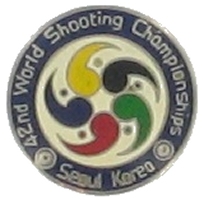
In 1971, the Taereung International Shooting Range in Seoul was completed, and in 1973, it was adopted as an official event for the National Youth Sports Festival. The 42nd World Shooting Championship 제42회 세계 사격선수권대회 was held there from Sept. 24 to Oct. 5, 1978, under the auspices of the International Shooting Sport Federation (ISSF). It is a significant event in that it is the first event to be held in Asia as a single Olympic event. It was also the first time in the world, that the competition was facilitated employing an automatic, electronic control system. Moreover, it was Korea’s first international championship in its sports history and served as a stepping stone for Korean sports to go global. There were 4,600 people, including 1,441 athletes and IOC members from 73 countries who participated in the 42nd World Shooting Championships, The men competed in 14 events and the women in 7 events. According to one website, there is a round Commemorative Medal and 3 diamond-shaped participation medals in gold, silver, and bronze. I suspect that this information on the number of medals is incorrect, but currently, it is all I have.
In 2018, the World Shooting Championships were held in Changwon, Gyeongsangnam-do, Korea for the first time in 40 years.
42nd World Shooting Championship Commemoration Medal
The Korean inscription on the obverse is repeated in English on the reverse, namely: “제42회 세계 사격선수권대회 / 대한민국 서울 / 1978”, 42nd World Shooting Championship, Seoul, Korea, 1978.
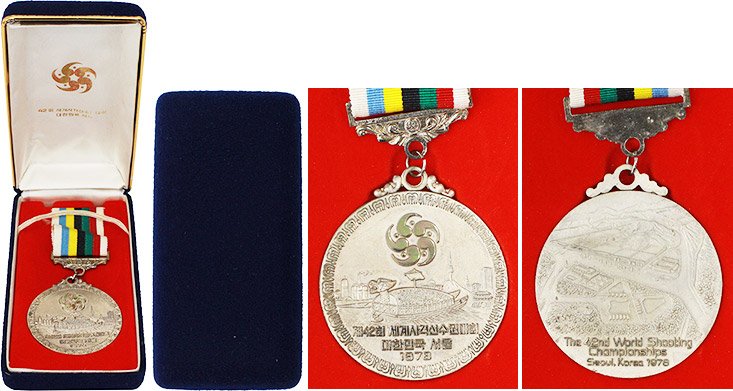
The Commemorative Medal has a 59.37 mm diameter and is 5 mm thick
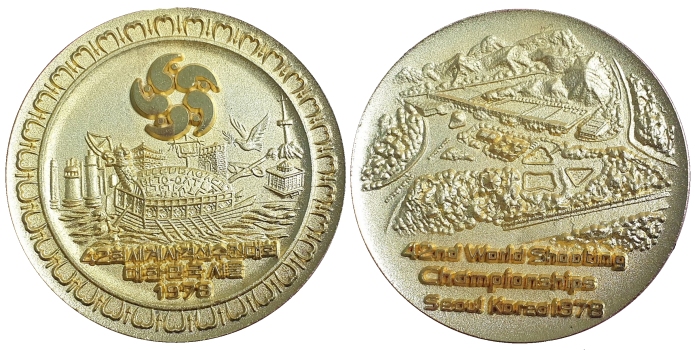
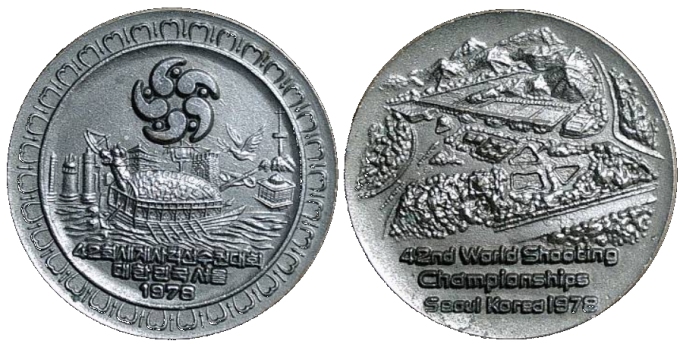
42nd World Shooting Championship Participation Medals
I have found these medals listed as Participation Medals, but I have been unable to ascertain what delineates who gets which Participation Medal; Gold, Silver, or Bronze. All the medals have a diameter of 61 mm and are 6 mm thick. Each medal comes in a bright red case, similar to the blue case shown above.
I can’t prove it, but I suspect that these medals are actually the “Winners Medals”. The one thing that lends credence to this assumption is the reverse image. This is the Silla Kingdom, Royal Gold Crown from Geumgwanchong 금관총 금관 (金冠塚金冠) and dates to the 5th–7th centuries.2 I have not found any other medal that came in Gold, Silver, and Bronze varieties.
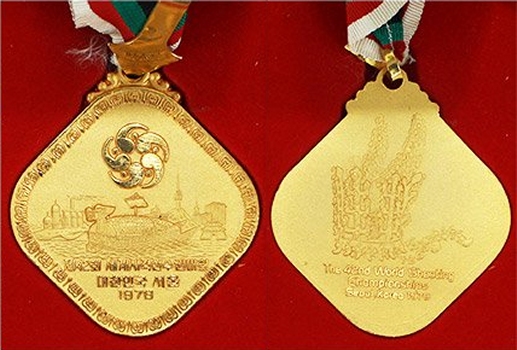
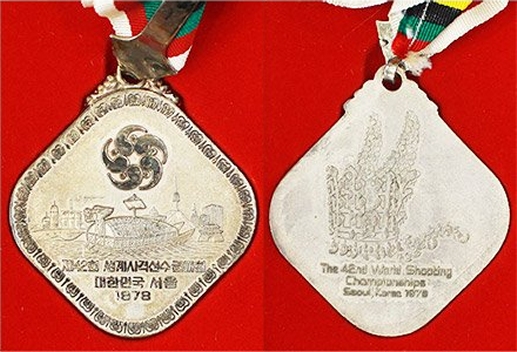
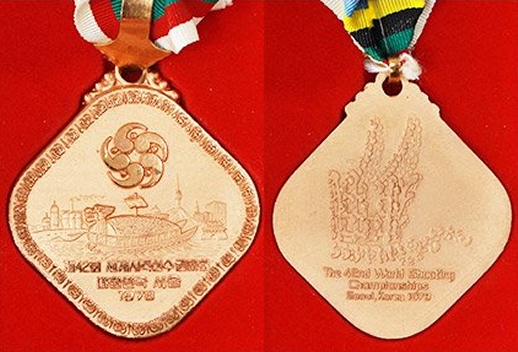
Other Event items found
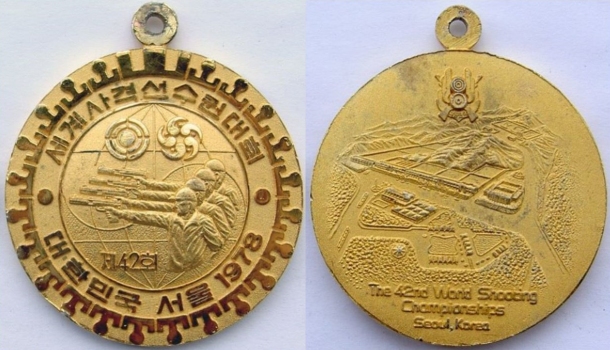
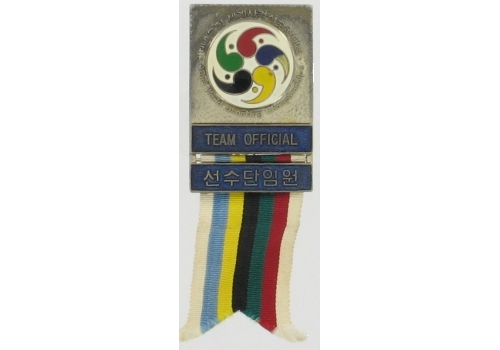
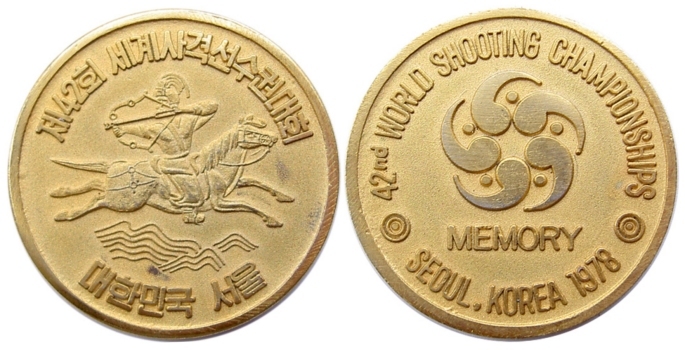
Uncertain if these were officially authorized or not.
The obverse Korean inscription is repeated on the reverse in English, with the added inclusion of the word “Memory” and “1978”.
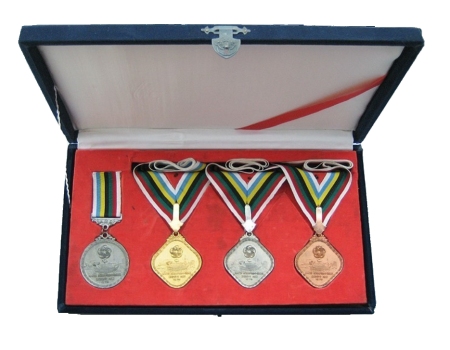
42nd World Shooting Championship Coins
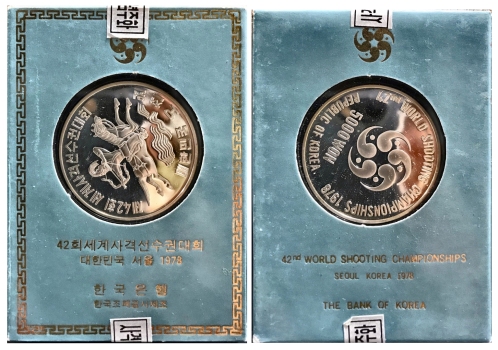
5,000 won: Reeded edge (170), 95% silver (Ag), 5% copper (Cu), 32 mm dia., 23 g., mintage 100,000 (inc. 20,000 unfrosted proof 유광 프루프) coins.
500 won: Reeded edge (160), 75% copper (Cu), 25% nickel (Ni), 32 mm dia, 17 g., mintage 1,000,000 (inc. 18,000 unfrosted proof 유광 프루프 and 2,000 matte proof 무광 프루프) coins.
Proof coins have a highly polished surface texture.
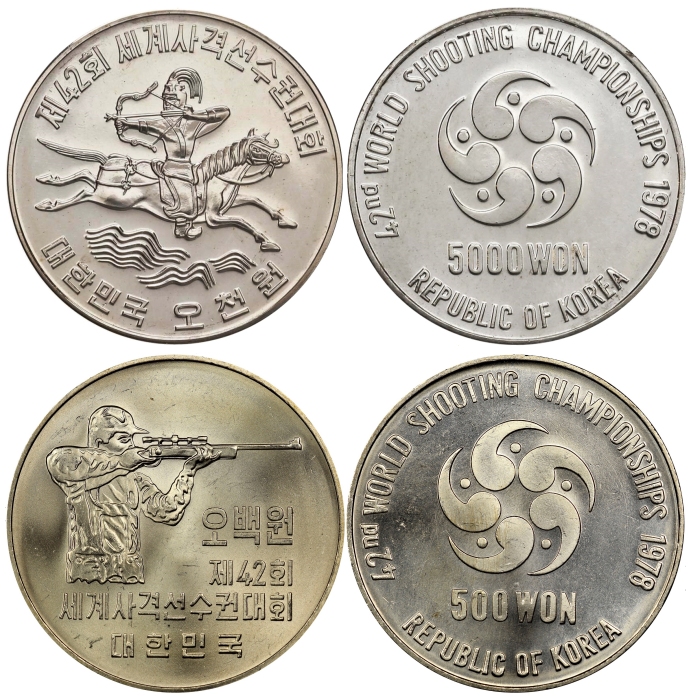
Footnotes:
- Information source: JoongAng Ilbo, Sept.19, 1977, “제1회 아주 여성 청소년 사격대회|7개국 104명 참가” The 1st Aju Female Youth Shooting Contest | 104 participants from 7 countries (the term 아주 “Aju” is a Korean word meaning “Asia”.
- The crown was designated as National Treasure #87 on December 12, 1962. It is 44 cm (17.3228 in.) in height and has a diameter of 19 cm (7.48031 in.). It is the largest golden crown from Silla discovered thus far.
